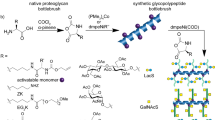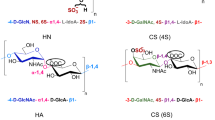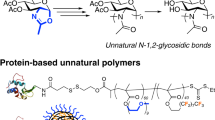Abstract
Glycopolymers with α-galactose (α-Gal) and α-mannose (α-Man) were synthesized by means of living radical polymerization with a reversible addition-fragment chain transfer reagent, and the thin-layer formation of glycopolymers was investigated in terms of protein recognition abilities. Thiol-terminated glycopolymers formed a thin layer of about 2.5 nm in thickness on a gold substrate, and the glycopolymer thin layer showed specific interaction with sugar recognition proteins (lectins and Shiga toxins (Stxs)). The interactions were highly specific, and the signal-to-noise ratio of protein recognition was greater than 16. Glycopolymer-substituted gold nanoparticles (GNPs) also showed biorecognition abilities and protein-specific aggregation. The protein recognition abilities of the GNPs were also analyzed. The glycopolymer-substituted GNPs were utilized for signal amplification of surface plasmon resonance (SPR) to detect protein-saccharide recognition. The glycopolymer with α-Gal showed a strong interaction with Stxs according to SPR measurements, suggesting a possible application of α-Gal-substituted GNPs in Stx-1 biosensing.
Similar content being viewed by others
Log in or create a free account to read this content
Gain free access to this article, as well as selected content from this journal and more on nature.com
or
References
Taylor, M. E. & Drickamaer, K. Introduction to Glycobiology (Oxford Press, London, 2002).
Jelinek, R. & Kolusheva, S. Carbohydrate biosensors. Chem. Rev. 104, 5987–6016 (2004).
Mammen, M., Choi, S. K. & Whitesides, G. M. Polyvalent interactions in biological systems: implications for design and use of multivalent ligands and inhibitors. Angew. Chem. Int. Ed. 37, 2754–2794 (1998).
Lee, T. C. & Lee, R. T. Carbohydrate-protein interactions: basis of glycobiology. Acc. Chem. Res. 28, 321–327 (1995).
Taylor, M. E., Bezouska, K. & Drickamer, K. Contribution to ligand binding by multiple carbohydrate-recognition domains in the macrophage mannose receptor. J. Biol. Chem. 267, 1719–1726 (1992).
Miura, Y., Ikeda, T. & Kobayashi, K. Chemoenzymatically synthesized glycoconjugate polymers. Biomacromolecules 4, 410–415 (2003).
Miura, Y., Sasao, Y., Dohi, H., Nishida, Y. & Kobayashi, K. Self-assembled monolayers of globotriaosylceramide (Gb3) mimics: surface specific affinity with shiga toxins. Anal. Biochem. 310, 27–35 (2002).
Miura, Y., Yasuda, K., Yamamoto, K., Koike, M., Nishida, Y. & Kobayashi, K. Inhibition of alzheimer amyloid aggregation with sulfated glycopolymers. Biomacromolecules 8, 2129–2134 (2007).
Toyoshima, M. & Miura, Y. Preparation of glycopolymer-substituted gold nanoparticles and their molecular recognition. J. Polym. Sci. Part A: Polym. Chem. 47, 1412–1421 (2009).
Moad, G., Rizzardo, E. & Tang, S. H. Living radical polymerization by the RAFT process. Aus. J. Chem. 58, 379–410 (2005).
Housni, A., Cai, H., Liu, S., Pun, S.H. & Narain, R. Facile preparation of glyconanoparticles and their bioconjugation to streptavidin. Langmuir 23, 5056–5061 (2007).
Kitano, H., Anraku, Y. & Shinohara, H. Sensing capabilities of colloidal gold monolayer modified with a phenylboronic acid-carrying polymer brush. Biomacromolecules 7, 1065–1071 (2006).
McCormick, C. L. & Lowe, A. B. Aqueous RAFT polymerization: recent developments in synthesis of functional water-soluble (Co)polymers with controlled structures. Acc. Chem. Res. 37, 312–325 (2004).
Wageesha, S., Luisa, A. & Christopher, K. O. Self-assembled monolayers and polymer brushes in biotechnology: current applications and future perspectives. Biomacromolecules 6, 2427–2448 (2005).
Uzawa, H., Ito, H., Neri, P., Mori, H. & Nishida, Y. Glycochips from polyanionic glycopolymers as tools for detecting shiga toxins. Chem. Biochem. 8, 2117–2124 (2007).
Matsumoto, E., Yamauchi, T., Fukuda, T. & Miura, Y. Sugar microarray via click chemistry: molecular recognition with lectins and amyloid β (1-42). Sci. Technol. Adv. Mater. 10, 34605–34611 (2009).
Miura, Y., Yamauchi, T., Sato, H. & Fukuda, T. The self-assembled monolayer of saccharide via click chemistry: Formation and protein recognition. Thin Solid Films 516, 2443–2449 (2008).
Levy, D. E. & Fugedi, P. Organic Chemistry of Sugars (Marcel Dekker Inc., New York, USA, 2005).
Nagatani, N., Tanaka, R., Yuhi, T., Endo, T., Kerman, K., Takamura, Y. & Tamiya, E. Gold nanoparticle-based novel enhancement method for the development of highly sensitive immunochromatographic test strips. Sci. Technol. Adv. Mater. 7, 270–275 (2006).
Thomas, D. B., Sumerlin, B. S., Lowe, A. B. & McCormick, C. L. Conditions for facile, controlled RAFT polymerization of acrylamide in water. Macromolecules 36, 1436–1439 (2003).
Sumerlin, B. S., Lowe, A. B., Stroud, P. A., Zhang, P., Urban, M. W. & McCormick, C. L. Modification of gold surfaces with water-soluble (Co)polymers prepared via aqueous reversible additionfragmentation chain transfer (RAFT) polymerization. Langmuir 19, 5559–5562 (2003).
Chakrabarti, A. Monte Carlo study of pancake to brush transition. J. Chem. Phys. 100, 631–635 (1994).
Tanaka, M., Mochizuki, A., Ishii, N., Motomura, T. & Hatakeyama, T. Study of blood compatibility with Poly(2-methoxyethyl acrylate). Relationship between water structure and platelet compatibility in poly(2-methoxyethylacrylate-co-2-hydroxyethylmethacrylate). Biomacromolecules 3, 36–41 (2002).
Ide, M., Mori, T., Ichikawa, K., Kitano, H., Tanaka, M., Mochizuki, A., Oshiyama, H. & Mizuno, W. Structure of water sorbed into poly(MEA-co-HEMA) films as examined by ATR-IR spectroscopy. Lagnmuir 19, 429–435 (2003).
Ladam, G., Vonna, L. & Sackmann, E. Micromechanics of surface-grafted hyaluronic acid gels. J. Phys. Chem. B. 107, 8965–8971 (2003).
Prime, K. L. & Whitesides, G. M. Self-assembled organic monolayers: model systems for studying adsorption of proteins at surfaces. Science 252, 1164–1167 (1991).
Satomi, T., Nagasaki, Y., Kobayashi, H., Otsuka, H. & Kataoka, K. Density control of Poly(ethylene glycol) layer to regulate cellular attachment. Langmuir 23, 6698–6703 (2007).
Waranabe, J. & Ishihara, K. Cell engineering biointerface focusing on cytocompatibility using phospholipid polymer with an isomeric oligo(lactic acid) segment. Biomacromolecules 6, 1797–1802 (2005).
Kitano, H., Tada, S., Mori, T., Takaha, K., Gemmei-Ide, M., Tanaka, M., Fukuda, M. & Yokoyama, Y. Correlation between the structure of water in the vicinity of carboxybetaine polymers and their blood-compatibility. Langmuir 21, 11932–11940 (2005).
Nagahori, N. & Nishimura, S. -I. Tailored glycopolymers: controlling the carbohydrateprotein interaction based on template effect. Biomacromolecules 2, 22–23 (2001).
Kawaguchi, T., Shankaran, D. R., Kim, S. -J., Matsumoto, K., Toko, K. & Miura, N. Surface plasmon resonance immunosensor using Au nanoparticle for detection of TNT. Sensors Actuators B Chem. B. 133, 467–472 (2008).
Wilets, K. A. & Van Duyne, R. P. Localized surface plasmon resonance spectroscopy and sensing. Annu. Rev. Phys. Chem. 58, 267–297 (2007).
Lingwood, C. A., Law, H., Richardson, S., Petric, M., Brunton, J. L., Grandis, S. D. & Karmali, M. Glycolipid binding of purified and recombinant Escherichia coli produced verotoxin in vitro. J. Biol. Chem. 262, 8834–8839 (1987).
Acknowledgements
This work was supported by a Grant-in-Aid for Young Scientists (B) (20750088).
Author information
Authors and Affiliations
Corresponding author
Additional information
Electronic supporting information available
The syntheses of glycomonomers, atomic force microscopy imaging of the glycopolymer-modified layer, SPR analyses, evaluation of GNPs and immunochromatography are available through the Internet.
Supplementary Information accompanies the paper on Polymer Journal website (http://www.nature.com/pj)
Supplementary information
Rights and permissions
About this article
Cite this article
Toyoshima, M., Oura, T., Fukuda, T. et al. Biological specific recognition of glycopolymer- modified interfaces by RAFT living radical polymerization. Polym J 42, 172–178 (2010). https://doi.org/10.1038/pj.2009.321
Received:
Revised:
Accepted:
Published:
Issue date:
DOI: https://doi.org/10.1038/pj.2009.321
Keywords
This article is cited by
-
Formation of a glyco-functionalized interface on polyethylene using a side-chain crystalline block copolymer with epoxide
Polymer Journal (2022)
-
SPR study for analysis of a water-soluble glycopolymer interface and molecular recognition properties
Polymer Journal (2017)
-
Design and synthesis of well-defined glycopolymers for the control of biological functionalities
Polymer Journal (2012)



